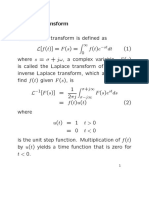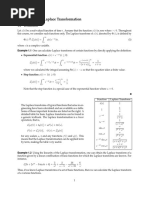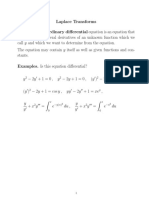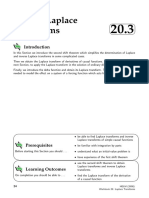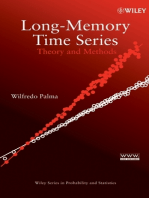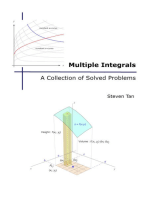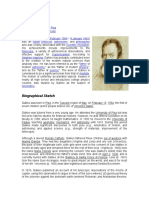1 Laplace Transform of Periodic Function
Uploaded by
asbadg1 Laplace Transform of Periodic Function
Uploaded by
asbadgS.
Ghorai
Lecture XIX
Laplace Transform of Periodic Functions, Convolution, Applications
Laplace transform of periodic function
Theorem 1. Suppose that f : [0, ) R is a periodic function of period T > 0, i.e.
f (t + T ) = f (t) for all t 0. If the Laplace transform of f exists, then
T
f (t)est dt
0
F (s) =
1 esT
(1)
Proof: We have
f (t)est dt
F (s) =
0
(n+1)T
f (t)est dt
=
nT
n=0
f (u + nT )esusnT du
=
n=0
esnT
u = t nT
f (u)esu du
0
n=0
T
su
f (u)e
esnT
du
n=0
f (u)esu du
=
1 esT
The last line follows from the fact that
esnT
n=0
is a geometric series with common ration esT < 1 for s > 0.
Example 1. Consider f (t) = sin(t), which is a periodic function of period 2/.
Solution: Using (1), we find
F (s) =
1
1 e2s/
2/
est sin(t) dt =
0
1 e2s/
= 2
2
2
2s/
s + 1e
s + 2
Example 2. Consider a saw-tooth function (see Figure 1)
f (t) =
t,
0 t < 1,
f (t 1),
t 1.
S. Ghorai
Figure 1: A saw-tooth function.
Solution: Here period T = 1. Using (1), we find
1
F (s) =
1 es
test dt =
0
1 es (1 + s)
1
es
=
s2 (1 es
s2 s(1 es )
Example 3. Consider the following function (see Figure 2)
0 t < 1,
t,
2 t,
1 t < 2,
f (t) =
f (t 2),
t 2.
f(t)
1
o
Figure 2: A saw-tooth function.
Solution: Here f (t) is a periodic function of period T = 2. Hence, using (1), we find
1
F (s) =
1 e2s
2
st
f (t)e
0
1
dt =
1 e2s
te
st
(2 t)est dt
dt +
1
Simplifying the RHS, we find
F (s) =
Aliter: Note that
(1 es )2
1 es
1
=
= 2 tanh(s/2)
2
2s
2
s
s (1 e )
s (1 + e )
s
1,
0 < t < 1,
1,
1 < t < 2,
f (t) =
f (t 2),
t > 2.
S. Ghorai
Since f is piecewise continuous and is of exponential order, its Laplace transform exist.
Also, f is periodic with period T = 2. Hence,
1
=
1 e2s
L f
f (t)e
st
1
dt =
1 e2s
2
st
est dt
dt +
(1 es )2
.
s(1 e2s )
Hence,
L f
1
1
1
tanh(s/2) = sF (s) f (0) = tanh(s/2) = F (s) = 2 tanh(s/2)
s
s
s
Comment: Is it possible to do similar calculations (like in aliter) in Example 2? If
not, why not?
Convolution
Suppose we know that a Laplace transform H(s) can be written as H(s) = F (s)G(s),
where L f (t) = F (s) and L g(t) = G(s). We need to know the relation of h(t) =
L1 H(s) to f (t) and g(t).
Definition 1. (Convolution) Let f and g be two functions defined in [0, ). Then
the convolution of f and g, denoted by f g, is defined by
t
(f g)(t) =
f ( )g(t ) d
(2)
Note: It can be shown (easily) that f g = g f . Hence,
t
(f g)(t) =
g( )f (t ) d
(3)
We use either (2) or (3) depending on which is easier to evaluate.
Theorem 2. (Convolution theorem) The convolution f g has the Laplace transform property
L (f g)(t) = F (s)G(s).
(4)
OR conversely
L1 F (s)G(s) = (f g)(t)
Proof: Using definition, we find
L (f g)(t)
(f g)(t)est dt
=
0
f ( )g(t ) d
=
0
est dt
The region of integration is the area in the first quadrant bounded by the t-axis and
S. Ghorai
=t
0110
1 1
0
10
1010
2
00000000
11111111
000000001010
11111111
0000000010
11111111
Figure 3: Effects of unit step function on a function f (t). Here b > a.
the line = t. The variable limit of integration is applied on which varies from = 0
to = t.
Let us change the order of integration, thus apply variable limit on t. Then t would
vary from t = to t = and would vary from = 0 to = . Hence, we have
L (f g)(t)
est g(t ) dt f ( ) d
=
0
esu g(u) du f ( )es d,
=
0
t =u
es f ( ) d
esu g(u) du
= F (s)G(s)
Example 4. Consider the same problem as given in Example 4 of Lecture Note 18,
i.e. find inverse Laplace transform of 1/s(s + 1)2 .
Solution: We write H(s) = F (s)G(s), where F (s) = 1/s and G(s) = 1/(s + 1)2 . Thus
f (t) = 1 and g(t) = tet . Hence, using convolution theorem, we find
t
e d = 1 (t + 1)et .
f (t )g( ) d =
h(t) =
0
Note: We have used f (t )g( ) in the convolution formula since f (t) = 1. This helps
a little bit in the evaluation of the integration.
Example 5. Find inverse Laplace transform of 1/(s2 + 2 )2 .
Solution: Let H(s) = F (s)G(s), where F (s) = 1/(s2 + 2 ) and G(s) = 1/(s2 + 2 ).
S. Ghorai
Thus, f (t) = sin(t)/ = g(t). Hence,
t
1
sin( ) sin((t ))d
2 0
1
sin(t) t cos(t) .
=
2 3
h(t) =
Applications
Example 6. (Differential equation) Solve the IVP
y + y = t,
y(0) = 0, y (0) = 2
Solution: Take Laplace transform on both sides. This gives
s2 Y 2 + Y =
1
2
1
=
Y
=
+
s2
s2 (s2 + 1) s2 + 1
Using partial fraction, we find
Y =
1
1
+
= y(t) = t + sin t
s2 s2 + 1
Aliter: In the method above, we evaluated Laplace transform of the nonhomogeneous
term in the right hand side. Now here we dont evaluate it. Let g(t) be nonhomogeneous
term (in this case g(t) = t). Let G(s) be the Laplace transform of g. Now Take Laplace
transform on both sides. This gives
s2 Y 2 + Y = G(s) = Y =
2
G(s)
+ 2
2
s +1 s +1
Taking inverse transform and convolution, we find
t
(t ) sin( ) dt + 2 sin t
g(t ) sin( ) dt + 2 sin t = y(t) =
y(t) =
0
OR (using integration by parts)
y(t) = t + sin t
Example 7. (Differential equation) Solve the IVP
y + 9y =
8 sin t,
0,
0 < t < ,
t > ,
y(0) = 0, y (0) = 4.
Solution: Consider g(t) = 8 u0 (t) u (t) sin t. Then Laplace transform of the
nonhomogeneous term is the same as that of g(t). Now we write g(t) as
g(t) = 8u0 (t) sin t + +8u (t) sin(t ).
S. Ghorai
Now taking Laplace transform of the ODE, we get
s2 Y 4+9Y =
1
8
es
4
1
s
+8
=
Y
=
+8
+8e
s2 + 1 s2 + 1
s2 + 9 (s2 + 1)(s2 + 9)
(s2 + 1)(s2 + 9)
Using partial fraction, we get
Y =
s2
4
+
+9
s2
1
1
2
+1 s +9
Now
1
sin 3t
3
L sin t
+ es
s2
1
1
2
+1 s +9
1
1
.
s2 + 1 s2 + 9
Hence, using shifting theorem and inverse transform, we find
y(t) =
4 sin 3t
1
1
+ sin t sin 3t + u (t) sin(t ) sin 3(t )
3
3
3
Further, this can be break up as
sin 3t + sin t,
y(t) =
4 sin 3t,
3
0 t ,
t ,
Example 8. (Differential equation) (Variable coefficient) Solve the IVP
y 2xy + 4y = 0,
y(0) = 1, y (0) = 0
Solution: Take Laplace Transform on both sides, we find
s2 Y sy(0) y (0) + 2
d
L (y ) + 4Y = 0,
ds
OR
s2 Y s+2
d
s 3
sY y(0) +4Y = 0 = 2sY +(s2 +6)Y = s = Y +
+
ds
2 s
This is linear equation. Hence,
2 /4
Y s3 es
OR
1
2
s3 es
2 /4
ds + C
2
s2 4
es /4
Y =
+
C
s3
s3
OR
1
4
es /4
Y = 3 +C 3 .
s s
s
Now it can be shown by Bromwich integral method (not in the syllabus) that
L
x2 1
2
4
es /4
s3
Y =
1
2
S. Ghorai
Hence, we find
y(t) = (1 2x2 ) + C
x2 1
2
4
OR
y(t) = (1 C/4) + (C/2 2)x2
Now y(0) = 1 = C = 4. Hence
y(x) = (1 2x2 )
Comment: If we expand es
2 /4
/s3 then we find
es /4
1
1
+ non-negative power of s.
=
s3
s3 4s
If we assume L1 (sk ) = 0, k = 0, 1, 2, , then we find
L
x2 1
2
4
es /4
=
s3
Example 9. (Integral equation) Solve
t
y(t )e2 d = 1,
y +
y(0) = 1.
Solution: Take Laplace Transform on both sides, we find
sY y(0) +
Y
1
s+2
2
1
=
= Y =
= Y =
s+2
s
s(s + 1)
s s+1
Hence,
y(t) = 2 et
You might also like
- Bombardier Aerospace 20140716 Business Aircraft Market Forecast - 2014 33No ratings yetBombardier Aerospace 20140716 Business Aircraft Market Forecast - 2014 3343 pages
- Laplace Transformation: 1. Basic NotionsNo ratings yetLaplace Transformation: 1. Basic Notions5 pages
- Laplace Transfom: T-Translation Rule 18.031, Haynes Miller and Jeremy OrloffNo ratings yetLaplace Transfom: T-Translation Rule 18.031, Haynes Miller and Jeremy Orloff6 pages
- AB2.9: Unit Step Function. Second Shifting Theorem. Dirac's Delta FunctionNo ratings yetAB2.9: Unit Step Function. Second Shifting Theorem. Dirac's Delta Function13 pages
- Files-2. Mathematical Preliminaries SE302 Topic 2 - Laplace TransformNo ratings yetFiles-2. Mathematical Preliminaries SE302 Topic 2 - Laplace Transform17 pages
- Introduction:-Laplace Transform Was Named After The Great FrenchNo ratings yetIntroduction:-Laplace Transform Was Named After The Great French7 pages
- Chapter 5: Laplace Transform and Its ApplicationsNo ratings yetChapter 5: Laplace Transform and Its Applications23 pages
- MA-108 Differential Equations I: Ronnie SebastianNo ratings yetMA-108 Differential Equations I: Ronnie Sebastian30 pages
- AB2.8: Transforms of Derivatives and Integrals. Differential EquationsNo ratings yetAB2.8: Transforms of Derivatives and Integrals. Differential Equations8 pages
- Step Functions and Laplace Transforms of Piecewise Continuous FunctionsNo ratings yetStep Functions and Laplace Transforms of Piecewise Continuous Functions20 pages
- Student Solutions Manual to Accompany Economic Dynamics in Discrete Time, secondeditionFrom EverandStudent Solutions Manual to Accompany Economic Dynamics in Discrete Time, secondedition4.5/5 (2)
- Mathematics 1St First Order Linear Differential Equations 2Nd Second Order Linear Differential Equations Laplace Fourier Bessel MathematicsFrom EverandMathematics 1St First Order Linear Differential Equations 2Nd Second Order Linear Differential Equations Laplace Fourier Bessel MathematicsNo ratings yet
- 2017 Year End: General Aviation Aircraft Shipment ReportNo ratings yet2017 Year End: General Aviation Aircraft Shipment Report7 pages
- Finding A Potential Function For Conservative Vector Fields - Math InsightNo ratings yetFinding A Potential Function For Conservative Vector Fields - Math Insight5 pages
- An Introduction To Functional DerivativesNo ratings yetAn Introduction To Functional Derivatives8 pages
- Previous Years Questions (2017-1983) Segment-Wise: Vector AnalysisNo ratings yetPrevious Years Questions (2017-1983) Segment-Wise: Vector Analysis13 pages
- Chapter 0 Introduction: Section 0.1: Why Calculus?No ratings yetChapter 0 Introduction: Section 0.1: Why Calculus?21 pages
- De Zg515 Computational Fluid Dynamics: BITS PilaniNo ratings yetDe Zg515 Computational Fluid Dynamics: BITS Pilani24 pages
- Geometric Harmonic Analysis III - Dorina Mitrea & Irina Mitrea & Marius MitreaNo ratings yetGeometric Harmonic Analysis III - Dorina Mitrea & Irina Mitrea & Marius Mitrea980 pages
- PDEs - Finite - Difference - Diffusion - Wave PDFNo ratings yetPDEs - Finite - Difference - Diffusion - Wave PDF7 pages
- Chapter IV. Complex Integration: IV.1. Riemann-Stieltjes IntegralsNo ratings yetChapter IV. Complex Integration: IV.1. Riemann-Stieltjes Integrals8 pages
- Class Xii Formula List (Based on Book-2 by Dr. Amit Bajaj)No ratings yetClass Xii Formula List (Based on Book-2 by Dr. Amit Bajaj)15 pages
- Math 112 Module 11 Derivative of Inverse Trigonometric FunctionsNo ratings yetMath 112 Module 11 Derivative of Inverse Trigonometric Functions15 pages
- SRM Institute of Science and Technology: 18Mee305T - Finite Element MethodNo ratings yetSRM Institute of Science and Technology: 18Mee305T - Finite Element Method19 pages
- Bombardier Aerospace 20140716 Business Aircraft Market Forecast - 2014 33Bombardier Aerospace 20140716 Business Aircraft Market Forecast - 2014 33
- Laplace Transfom: T-Translation Rule 18.031, Haynes Miller and Jeremy OrloffLaplace Transfom: T-Translation Rule 18.031, Haynes Miller and Jeremy Orloff
- AB2.9: Unit Step Function. Second Shifting Theorem. Dirac's Delta FunctionAB2.9: Unit Step Function. Second Shifting Theorem. Dirac's Delta Function
- Files-2. Mathematical Preliminaries SE302 Topic 2 - Laplace TransformFiles-2. Mathematical Preliminaries SE302 Topic 2 - Laplace Transform
- Introduction:-Laplace Transform Was Named After The Great FrenchIntroduction:-Laplace Transform Was Named After The Great French
- AB2.8: Transforms of Derivatives and Integrals. Differential EquationsAB2.8: Transforms of Derivatives and Integrals. Differential Equations
- Step Functions and Laplace Transforms of Piecewise Continuous FunctionsStep Functions and Laplace Transforms of Piecewise Continuous Functions
- Computer Solved: Nonlinear Differential EquationsFrom EverandComputer Solved: Nonlinear Differential Equations
- Student Solutions Manual to Accompany Economic Dynamics in Discrete Time, secondeditionFrom EverandStudent Solutions Manual to Accompany Economic Dynamics in Discrete Time, secondedition
- Multiple Integrals, A Collection of Solved ProblemsFrom EverandMultiple Integrals, A Collection of Solved Problems
- Mathematics 1St First Order Linear Differential Equations 2Nd Second Order Linear Differential Equations Laplace Fourier Bessel MathematicsFrom EverandMathematics 1St First Order Linear Differential Equations 2Nd Second Order Linear Differential Equations Laplace Fourier Bessel Mathematics
- Transformation of Axes (Geometry) Mathematics Question BankFrom EverandTransformation of Axes (Geometry) Mathematics Question Bank
- 2017 Year End: General Aviation Aircraft Shipment Report2017 Year End: General Aviation Aircraft Shipment Report
- Finding A Potential Function For Conservative Vector Fields - Math InsightFinding A Potential Function For Conservative Vector Fields - Math Insight
- Previous Years Questions (2017-1983) Segment-Wise: Vector AnalysisPrevious Years Questions (2017-1983) Segment-Wise: Vector Analysis
- Chapter 0 Introduction: Section 0.1: Why Calculus?Chapter 0 Introduction: Section 0.1: Why Calculus?
- De Zg515 Computational Fluid Dynamics: BITS PilaniDe Zg515 Computational Fluid Dynamics: BITS Pilani
- Geometric Harmonic Analysis III - Dorina Mitrea & Irina Mitrea & Marius MitreaGeometric Harmonic Analysis III - Dorina Mitrea & Irina Mitrea & Marius Mitrea
- Chapter IV. Complex Integration: IV.1. Riemann-Stieltjes IntegralsChapter IV. Complex Integration: IV.1. Riemann-Stieltjes Integrals
- Class Xii Formula List (Based on Book-2 by Dr. Amit Bajaj)Class Xii Formula List (Based on Book-2 by Dr. Amit Bajaj)
- Math 112 Module 11 Derivative of Inverse Trigonometric FunctionsMath 112 Module 11 Derivative of Inverse Trigonometric Functions
- SRM Institute of Science and Technology: 18Mee305T - Finite Element MethodSRM Institute of Science and Technology: 18Mee305T - Finite Element Method











